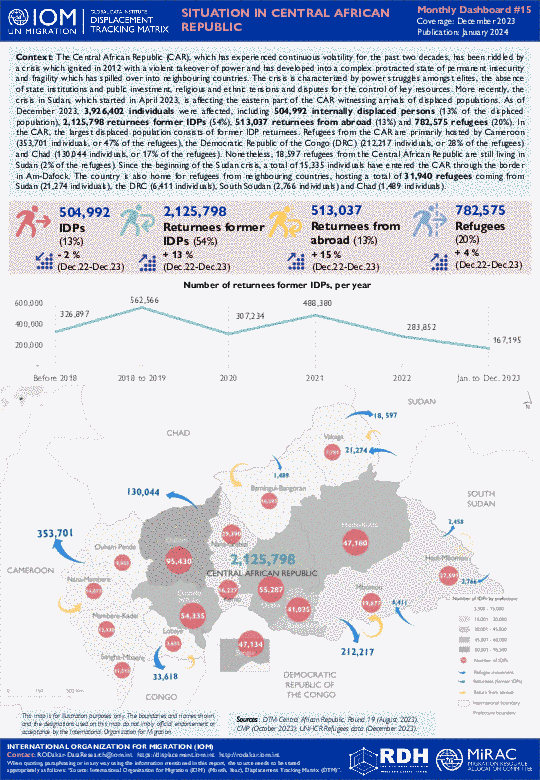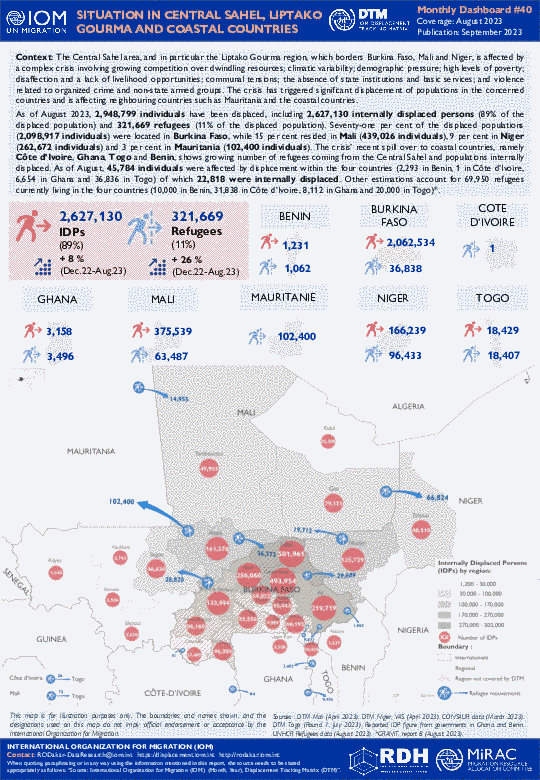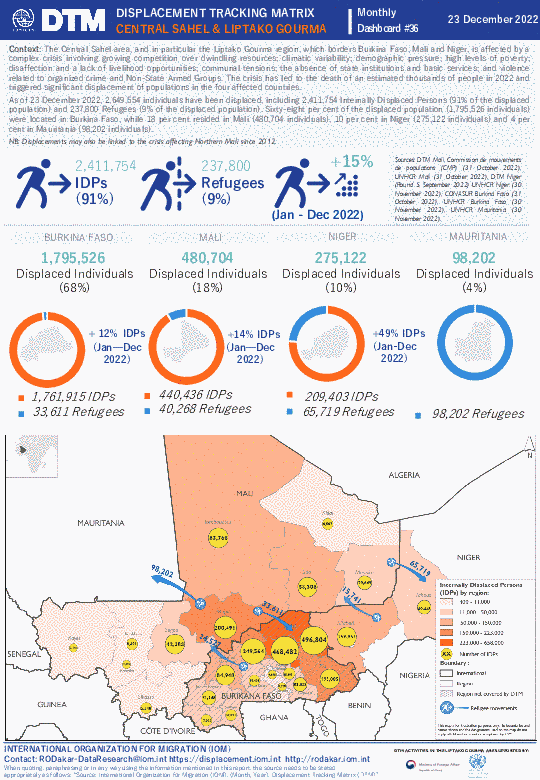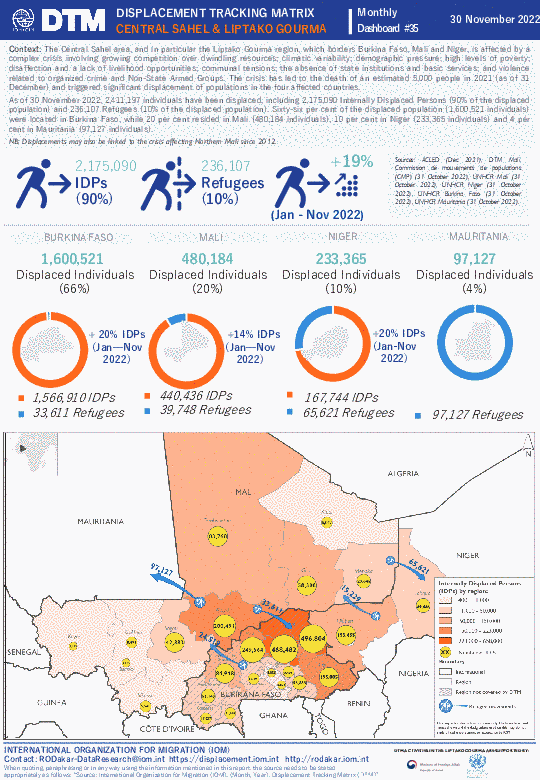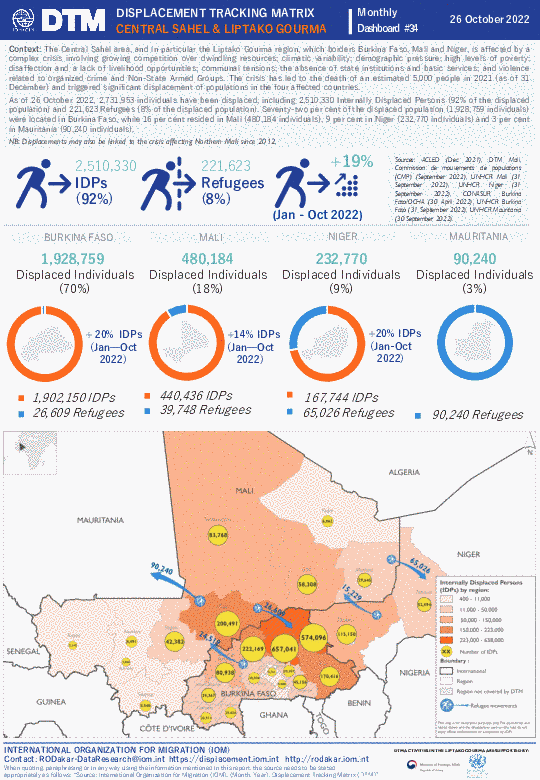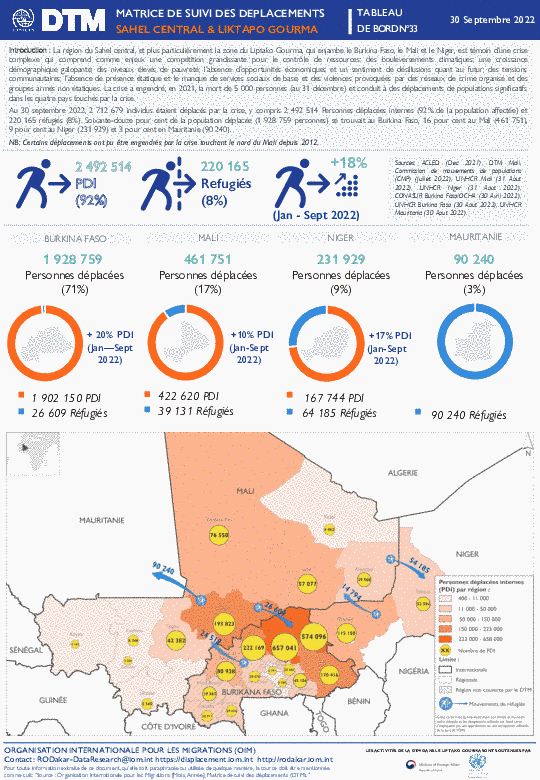-
Countries
-
Data and Analysis
-
Special Focus
-
Crisis Responses
Liptako Gourma Crisis Monthly Dashboard
Title Standard
West and Central Africa — Liptako Gourma Crisis Monthly Dashboard # (DATE)
Contact
RO Dakar, RODakar-DataResearch@iom.int
Type
Component
Domain
Confidential
Region
The Central Sahel area, and in particular the Liptako Gourma region, which borders Burkina Faso, Mali and Niger, is affected by a complex crisis involving growing competition over dwindling resources; climatic variability; demographic pressure; high levels of poverty; disaffection and a lack of livelihood opportunities; communal tensions; the absence of state institutions and basic services; and violence related to organized crime and non-state armed groups. The crisis has triggered significant displacement of populations in the concerned countries and is affecting neighbouring countries such as Mauritania and the coastal countries.
As of February 2024, 3,025,322 individuals have been displaced, including 2,636,880 internally displaced persons (87% of the displaced population) and 388,442 refugees (13% of the displaced population). Sixty-nine per cent of the displaced populations (2,100,469 individuals) were located in Burkina Faso, while 14 per cent resided in Mali (419,534 individuals), 10 per cent in Niger (287,223 individuals) and 4 per cent in Mauritania (114,653 individuals). The crisis’ recent spill over to coastal countries, namely Côte d’Ivoire, Ghana, Togo and Benin, shows growing number of refugees coming from the Central Sahel and populations internally displaced. As of February, 103,443 individuals were affected by displacement within the four countries (9,899 in Benin, 40,093 in Côte d’Ivoire, 7,142 in Ghana and 46,309 in Togo) of which 30,372 were internally displaced.
The Central African Republic (CAR), which has experienced continuous volatility for the past two decades, has been riddled by a crisis which ignited in 2012 with a violent takeover of power and has developed into a complex protracted state of permanent insecurity and fragility which has spilled over into neighbouring countries. The crisis is characterized by power struggles amongst elites, the absence of state institutions and public investment, religious and ethnic tensions and disputes for the control of key resources. More recently, the crisis in Sudan, which started in April 2023, is affecting the eastern part of the CAR witnessing arrivals of displaced populations.
As of December 2023, 3,926,402 individuals were affected, including 504,992 internally displaced persons (13% of the displaced population), 2,125,798 returnees former IDPs (54%), 513,037 returnees from abroad (13%) and 782,575 refugees (20%). In the CAR, the largest displaced population consists of former IDP returnees. Refugees from the CAR are primarily hosted by Cameroon (353,701 individuals, or 47% of the refugees), the Democratic Republic of the Congo (DRC) (212,217 individuals, or 28% of the refugees) and Chad (130,044 individuals, or 17% of the refugees).
The Central Sahel area, and in particular the Liptako Gourma region, which borders Burkina Faso, Mali and Niger, is affected by a complex crisis involving growing competition over dwindling resources; climatic variability; demographic pressure; high levels of poverty; disaffection and a lack of livelihood opportunities; communal tensions; the absence of state institutions and basic services; and violence related to organized crime and non-state armed groups. The crisis has triggered significant displacement of populations in the concerned countries and is affecting neighbouring countries such as Mauritania and the coastal countries.
As of August 2023, 2,948,799 individuals have been displaced, including 2,627,130 internally displaced persons (89% of the displaced population) and 321,669 refugees (11% of the displaced population). Seventy-one per cent of the displaced populations (2,098,917 individuals) were located in Burkina Faso, while 15 per cent resided in Mali (439,026 individuals), 9 per cent in Niger (262,672 individuals) and 3 per cent in Mauritania (102,400 individuals). The crisis’ recent spill over to coastal countries, namely Côte d’Ivoire, Ghana, Togo and Benin, shows growing number of refugees coming from the Central Sahel and populations internally displaced. As of August, 45,784 individuals were affected by displacement within the four countries (2,293 in Benin, 1 in Côte d’Ivoire, 6,654 in Ghana and 36,836 in Togo) of which 22,818 were internally displaced. Other estimations account for 69,950 refugees currently living in the four countries (10,000 in Benin, 31,838 in Côte d’Ivoire, 8,112 in Ghana and 20,000 in Togo)*.
The Central Sahel area, and in particular the Liptako Gourma region, which borders Burkina Faso, Mali and Niger, is affected by a complex crisis involving growing competition over dwindling resources; climatic variability; demographic pressure; high levels of poverty; disaffection and a lack of livelihood opportunities; communal tensions; the absence of state institutions and basic services; and violence related to organized crime and non-state armed groups. The crisis has triggered significant displacement of populations in the concerned countries and is affecting neighbouring countries such as Mauritania and the coastal countries.
As of July 2023, 2,911,228 individuals have been displaced, including 2,614,709 internally displaced persons (90% of the displaced population) and 296,519 refugees (10% of the displaced population). Seventy-two per cent of the displaced populations (2,098,917 individuals) were located in Burkina Faso, while 15 per cent resided in Mali (437,842 individuals), 8 per cent in Niger (233,041 individuals) and 3 per cent in Mauritania (101,844 individuals). The crisis’ recent spill over to coastal countries, namely Côte d’Ivoire, Ghana, Togo and Benin, shows growing number of refugees coming from the Central Sahel and populations internally displaced. As of July, 39,584 individuals were affected by displacement within the four countries (2,293 in Benin, 6,316 in Côte d’Ivoire, 6,598 in Ghana and 24,377 in Togo) of which 10,397 were internally displaced. Other estimations account for 63,831 refugees currently living in the four countries (10,000 in Benin, 25,719 in Côte d’Ivoire, 8,112 in Ghana and 20,000 in Togo).
The Central Sahel area, and in particular the Liptako Gourma region, which borders Burkina Faso, Mali and Niger, is affected by a complex crisis involving growing competition over dwindling resources; climatic variability; demographic pressure; high levels of poverty; disaffection and a lack of livelihood opportunities; communal tensions; the absence of state institutions and basic services; and violence related to organized crime and non-state armed groups. The crisis has triggered significant displacement of populations in the concerned countries and is affecting neighbouring countries such as Mauritania and the coastal countries.
As of June 2023, 2,869,892 individuals have been displaced, including 2,614,709 internally displaced persons (91% of the displaced population) and 255,183 refugees (9% of the displaced population). Seventy-three per cent of the displaced populations (2,098,917 individuals) were located in Burkina Faso, while 14 per cent resided in Mali (410,039 individuals), 8 per cent in Niger (233,041 individuals) and 3 per cent in Mauritania (98,474 individuals). The crisis’ recent spill over to coastal countries, namely Côte d’Ivoire, Ghana, Togo and Benin, shows growing number of refugees coming from the Central Sahel and populations internally displaced. As of June, 29,421 individuals were affected by displacement within the four countries (2,294 in Benin, 6,316 in Côte d’Ivoire, 6,311 in Ghana and 14,500 in Togo) of which 10,397 were internally displaced.
The Central Sahel area, and in particular the Liptako Gourma region, which borders Burkina Faso, Mali and Niger, is affected by a complex crisis involving growing competition over dwindling resources; climatic variability; demographic pressure; high levels of poverty; disaffection and a lack of livelihood opportunities; communal tensions; the absence of state institutions and basic services; and violence related to organized crime and non-state armed groups. The crisis has triggered significant displacement of populations in the concerned countries and is affecting neighbouring countries such as Mauritania and the coastal countries.
As of May 2023, 2,863,479 individuals have been displaced, including 2,617,185 internally displaced persons (91% of the displaced population) and 246,294 refugees (9% of the displaced population). Seventy-three per cent of the displaced populations (2,090,328 individuals) were located in Burkina Faso, while 14 per cent resided in Mali (410,039 individuals), 8 per cent in Niger (235,217 individuals) and 3 per cent in Mauritania (98,474 individuals). The crisis’ recent spill over to coastal countries, namely Côte d’Ivoire, Ghana, Togo and Benin, shows growing number of refugees coming from the Central Sahel and populations internally displaced. As of May, 29,421 individuals were affected by displacement within the four countries (2,294 in Benin, 6,316 in Côte d’Ivoire, 6,311 in Ghana and 14,500 in Togo) of which 10,397 were internally displaced.
The Central Sahel area, and in particular the Liptako Gourma region, which borders Burkina Faso, Mali and Niger, is affected by a complex crisis involving growing competition over dwindling resources; climatic variability; demographic pressure; high levels of poverty; disaffection and a lack of livelihood opportunities; communal tensions; the absence of state institutions and basic services; and violence related to organized crime and Non-State Armed Groups. The crisis has led to the death of an estimated thousands of people in 2022 and triggered significant displacement of populations in the four affected countries.
As of 23 December 2022, 2,649,554 individuals have been displaced, including 2,411,754 Internally Displaced Persons (91% of the displaced population) and 237,800 Refugees (9% of the displaced population). Sixty-eight per cent of the displaced population (1,795,526 individuals) were located in Burkina Faso, while 18 per cent resided in Mali (480,704 individuals), 10 per cent in Niger (275,122 individuals) and 4 per cent in Mauritania (98,202 individuals).
The Central Sahel area, and in particular the Liptako Gourma region, which borders Burkina Faso, Mali and Niger, is affected by a complex crisis involving growing competition over dwindling resources; climatic variability; demographic pressure; high levels of poverty; disaffection and a lack of livelihood opportunities; communal tensions; the absence of state institutions and basic services; and violence related to organized crime and Non-State Armed Groups. The crisis has led to the death of an estimated 5,000 people in 2021 (as of 31 December) and triggered significant displacement of populations in the four affected countries.
As of 30 November 2022, 2,411,197 individuals have been displaced, including 2,175,090 Internally Displaced Persons (90% of the displaced population) and 236,107 Refugees (10% of the displaced population). Sixty-six per cent of the displaced population (1,600,521 individuals) were located in Burkina Faso, while 20 per cent resided in Mali (480,184 individuals), 10 per cent in Niger (233,365 individuals) and 4 per cent in Mauritania (97,127 individuals).
The Central Sahel area, and in particular the Liptako Gourma region, which borders Burkina Faso, Mali and Niger, is affected by a complex crisis involving growing competition over dwindling resources; climatic variability; demographic pressure; high levels of poverty; disaffection and a lack of livelihood opportunities; communal tensions; the absence of state institutions and basic services; and violence related to organized crime and Non-State Armed Groups. The crisis has led to the death of an estimated 5,000 people in 2021 (as of 31 December) and triggered significant displacement of populations in the four affected countries.
As of 26 October 2022, 2,731,953 individuals have been displaced, including 2,510,330 Internally Displaced Persons (92% of the displaced population) and 221,623 Refugees (8% of the displaced population). Seventy-two per cent of the displaced population (1,928,759 individuals) were located in Burkina Faso, while 16 per cent resided in Mali (480,184 individuals), 9 per cent in Niger (232,770 individuals) and 3 per cent in Mauritania (90,240 individuals).
La région du Sahel central, et plus particulièrement la zone du Liptako Gourma, qui enjambe le Burkina Faso, le Mali et le Niger, est témoin d’une crise complexe qui comprend comme enjeux une compétition grandissante pour le contrôle de ressources; des bouleversements climatiques; une croissance démographique galopante; des niveaux élevés de pauvreté; l’absence d’opportunités économiques et un sentiment de désillusions quant au futur; des tensions communautaires; l’absence de présence étatique et le manque de services sociaux de base; et des violences provoquées par des réseaux de crime organisé et des groupes armés non étatiques. La crise a engendré, en 2021, la mort de 5 000 personnes (au 31 décembre) et conduit à des déplacements de populations significatifs dans les quatre pays touchés par la crise.
Au 30 septembre 2022, 2 712 679 individus étaient déplacés par la crise, y compris 2 492 514 Personnes déplacées internes (92% de la population affectée) et 220 165 réfugiés (8%). Soixante-douze pour cent de la population déplacée (1 928 759 personnes) se trouvait au Burkina Faso, 16 pour cent au Mali (461 751), 9 pour cent au Niger (231 929) et 3 pour cent en Mauritanie (90 240).
NB: Certains déplacements ont pu être engendrés par la crise touchant le nord du Mali depuis 2012.
Pagination
- Page 1
- Next page

